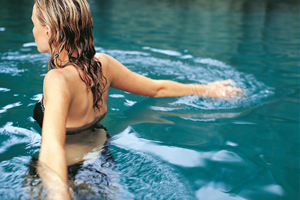


 Chlorine or Bromine. Which is the best sanitiser for your pool?
Chlorine or Bromine. Which is the best sanitiser for your pool?
This article compares chlorine and bromine and looks at the differences between them as pool sanitisers.
Clean water; the basics.
The water in your pool should be clear enough to see a coin sitting on the bottom at the deep end and it should feel good on your skin.
The only way to achieve water like that is to kill off bacteria with a disinfectant, get rid of organic matter through oxidation and keep the basic elements of the water in balance.
Pool water chemistry is a balancing act; a change in one area can affect the entire chemistry of your pool.
Either chlorine or bromine can be used as a sanitiser; that is, a chemical that kills bacteria and other micro-organisms. Each has slightly different properties although they do the same job.
Chlorine.
Chlorine is popular because it is both an oxidiser and a sanitiser.
Chlorine kills bacteria, controls algae and combines with their remains and other debris to form Chloramines. Once it has become Chloramine it no longer works as a sanitiser and it is these Chloramines that produce the unpleasant smell of Chlorine so often smelt in badly managed pools.
Shocking removes the Chloramines by breaking them down into Nitrogen and Chlorine gas and both disappear from the water.
With chlorine sanitisers the pH of your pool water is critical and must be kept at between 7.4 and 7.6 – all part of that balancing act we talked about earlier.
If your pool gets a very heavy amount of use and you use chlorine as a sanitiser, then you will have to shock the pool regularly and run the filter for longer.
On the other hand, chlorine is very easy to use as long as the pH and alkalinity are correctly balanced and chlorine offers a very competitive option both in terms of time and money.
Bromine.
Bromine is a very similar chemical element to Chlorine.
Bromine kills bacteria, controls algae and combines with organic debris to form Bromamines. Where Bromine differs from Chlorine is that these Bromamines have little or no smell and are still very good sanitisers.
Bromine is also less sensitive to pH balance and will work in a pool with a pH reading of anywhere between 7.0 and 8.0.
Bromine pools do occasionally need to be shocked with Chlorine but when you do this, the Chlorine oxidises to form Hypobrumus Acid and the Chlorine is liberated. Once a pool is treated with Bromine it is always a Bromine pool until it is drained and re-filled.
Using Bromine is slightly more complicated than a Chlorine system and it’s a good idea to get help and advice from your pool professional when starting to use Bromine as a sanitiser.
Bromine is generally more stable at higher water temperatures and so is often used to treat indoor pools and spas.
Which is the best choice to make?
The choice between Bromine and Chlorine is down to personal taste and your particular circumstances.
If your pool is indoor then Bromine may well be a better choice for you.
If cost and ease of use is your biggest concern then Chlorine comes out on top.
Bromine means that you won’t get that ‘chlorine smell’ but a carefully maintained, chlorinated pool will be odour free as well. Bromine is less sensitive to pH balance and that can be a real plus.
If you’d like help in contacting a pool professional in your area in order to discuss the options in more depth and how they suit your specific circumstances, then there is a contact button at the top right of this article that will get the process started.
If there is anything you would like to add to this article or if you would like to leave a comment then please just use the reply box below.